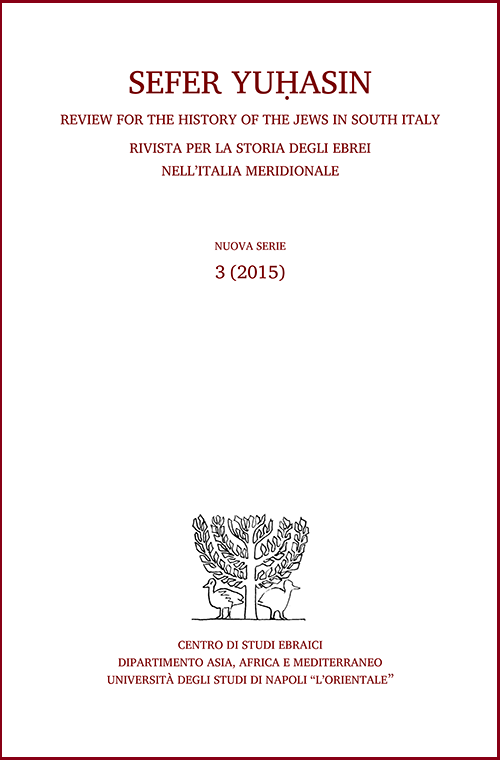Origini siciliane e fasti romani di Ferdinando Balami, archiatra pontificio, poeta e traduttore della prima metà del secolo XVI
Abstract
Quella di Ferdinando Balami è senza dubbio una straordinaria carriera, che si svolge all’ombra del potere pontificio nella Roma del Rinascimento. Figlio di ebrei o giudeoconversi siciliani emigrati nell’Urbe a seguito dell’espulsione del 1492-93, grazie all’esercizio dell’arte medica Balami riesce a scalare i vertici della sua professione nella città eterna e con i proventi accumulati dalla sua artegiunge a farsi costruire nel centro di Roma una sfarzosa palazzina da Antonio da Sangallo il Giovane. Balami conosce e frequenta l’accademia, il convivio e pratica la composizione e lo scambio di versi poetici ma, soprattutto, forte della sua consolidata posizione alla corte dei papi riesce a sfruttare la rete di amicizie legate al suo ruolo di medico e archiatra pontificio, intrattenendo relazioni con i maggiori esponenti culturali e politici del tempo uniti dal comune progetto filomediceo. Balami si rivela essere un medico umanista che, nel solco della tradizione secolare degli ebrei di Sicilia, fa della conoscenza delle lingue e della traduzione di testi uno strumento di potere e di ascesa sociale. La sua attività di traduttore di testi galenici dal greco al latino lo proietta indubbiamente nell’avanguardia intellettuale del tempo, e lo affida alla posterità dei suoi continuatori e critici. Nella Roma tra XV e XVI secolo, si comincia a profilare infine la presenza di un certo numero di “siciliani”, ebrei o cristiani novelli, che formano una vera e propria “rete mirabile”, che ha avuto accesso all’Urbe grazie ai rapporti di clientela e patronage con eminenti famiglie che nutrivano interessi e relazioni con l’isola.
Sicilian Origins and Roman Splendours of Ferdinando Balami: Pontifical Archiater, Poet and Translator of the First Half of the 16th Century
The career of Ferdinando Balami, which took place in the shadow of papal power in Renaissance Rome, was unquestionably extraordinary. He was the son of Sicilian Jews, or Jewish converts, who had emigrated to the Urbe following the exile of 1492-93. Balami practised medicine and managed to scale the heights of his profession in the eternal city and the earnings he accumulated enabled him to have a luxurious palace in the centre of Rome, designed by Antonio da Sangallo the Younger. Balami knew and frequented the academia and the banquets: he, too, composed and exchanged verses of poetry, and, thanks to his established position at the papal court, he managed to exploit this network of friendships cultivated by means of his role as physician and pontifical archiater, maintaining relationships with the greatest cultural and political exponents of the time, united by a shared philo-Medici project. Over the course of his life in Rome, Balami showed himself to be a humanist physician who, following the centuries-old tradition of the Jews of Sicily, made his knowledge of languages and ability to translate of texts into instruments of power and social success. His role as a translator of Galen’s texts from Greek into Latin undoubtedly transported him into the intellectual avant-garde of the time and earned him a place in posterity with his successors and critics. Furthermore, in Rome between the 15th and 16th centuries, one begins to see a certain number of “Sicilians”, either Jews or new Christians, who formed a rete mirabile (“remarkable network”) that had access to the Urbe thanks to the relationships of patronage with eminent families who maintained interests in and ties to the island.
Downloads
Gli autori che pubblicano su questa rivista accettano le seguenti condizioni:
- Gli autori mantengono i diritti sulla loro opera e cedono alla rivista il diritto di prima pubblicazione dell'opera, contemporaneamente licenziata sotto una Licenza Creative Commons - Attribuzione che permette ad altri di condividere l'opera indicando la paternità intellettuale e la prima pubblicazione su questa rivista.
- Gli autori possono aderire ad altri accordi di licenza non esclusiva per la distribuzione della versione dell'opera pubblicata (es. depositarla in un archivio istituzionale o pubblicarla in una monografia), a patto di indicare che la prima pubblicazione è avvenuta su questa rivista.
- Gli autori possono diffondere la loro opera online (es. in repository istituzionali o nel loro sito web) prima e durante il processo di submission, poiché può portare a scambi produttivi e aumentare le citazioni dell'opera pubblicata (Vedi The Effect of Open Access).

